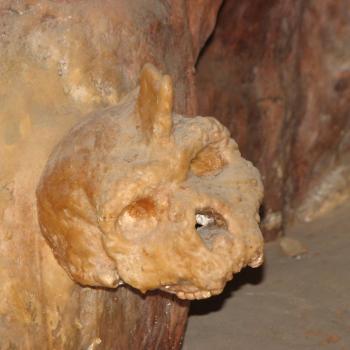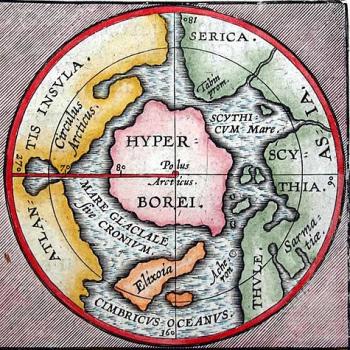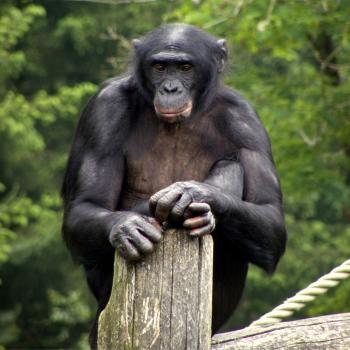
Ancient and indigenous cultures around the world identified trees with long lifespans and medicinal properties as the axis of the universe, linking the earthly realm to the spirit world of sky and stars.
Deeply rooted in sacred springs and reaching up to the Milky Way, world trees were often very tall and virtually always featured white flowers, berries, bark or sap to represent their reach to the stars. Virtually every part of a “world tree” was used for healing the body, mind and/or spirit.
The origin of the magic wand
Modern folklorists trace the magic wand to the Hebrew Bible and the rod of Aaron, which miraculously sprouted an almond tree as a demonstration of god’s power, but it may be much older.
Cutting a hazel tree down to the stump – a common ancient practice known as coppicing – causes the tree to grow back in a different form. Rather than growing normal thick branches, the injured hazel produces long, thin and flexible rods.
From the viewpoint of a pagan naturalist, the hazel’s self-healing response to severe injury was not only regenerative but also transformational; the new growth was different than the old. After a severe injury came a new and different life.
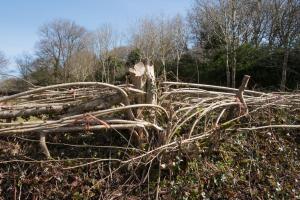
The Greek messenger god Hermes carried a hazel rod when conducting the souls of the dead to the underworld. Ireland’s pagan kings were depicted with hazel rods that signified royal lineage. The etymology of the modern word “wand” traces back to Old Norse and Proto-Germanic, meaning flexible rod or switch.
The magic wand’s most common use in stories is to instantly change one thing into another. Perhaps the origin of this magic was the transformative properties of certain trees, including species traditionally used to make wands.
In Zoroastrian myth, divine birds took sprigs from a white Haoma tree growing in a mountain paradise and flew them down to earth for human cultivatation. Coppicing the Haoma tree produced offshoots known as Barsom, which were used in Zoroastrian rituals. An elixir made from the Haoma was said to bestow health, fertility and immortality.
Scholars have noted that the legend and traits of the Haoma tree are identical to the Hindu plant and ritual drink known as Soma. In both cultures the plants used to make the ritual drinks both contain psychoactive alkaloids.
Sycamores in ancient Egypt
Strikingly similar world trees can be found in Africa, Europe, India, China and the Americas.
Along the Nile River the sycamore tree runs with white (latex) sap, grows up to 65 feet tall and can live up to 600 years. Featuring a white fruit with a red center, the sycamore figs of ancient Egypt were made into a milky paste that was fed to newborns.
On a pillar in the tomb of King Thutmose III, the king is shown suckling the Milky Way goddess Isis in the form of a sycamore tree. Isis was also associated with the star Sirius in the Milky Way, the brightest star in the northern hemisphere, which rises with the sun in June and was associated with the annual flooding of the Nile.
Hazel trees in paradise
The hazel is a short, bushy tree that blooms in late winter, producing nuts with a nutritious white pasty center that’s easily made into a milky drink. A recent archaeological study showed hazel nuts were a commodity of exchange in Neolithic Europe, based on a massive cache of shells dating back 9,000 years on the Scottish island of Colonsay.
In Irish legend, nine hazelnut trees grew in a heavenly paradise where they dropped their nuts into a sacred well. The goddess Boann walked three times around the well, causing it to overflow into the Milky Way and create the River Boyne. The nuts were said to cause bubbles of inspiration and every seven years, drinking from the waters of the Boyne was said to bestow the gift of spontaneous poetry.
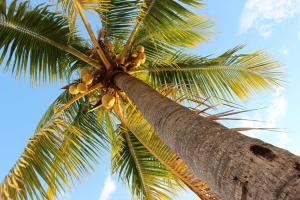
Bathing the gods in coconut milk
Found across India and Southeast Asia, the coconut palm grows up to 80 feet and produces white fruit that’s grated and mixed with water to make coconut milk. The Hindu river goddess Sarawati embodied the flow of water from the Milky Way to the snow-capped Mt. Meru, where the coconut palm grew in Lord Indra’s garden.
The coconut palm was one of many healing gifts that emerged from the mythic Churning of the Ocean of Milk, when the gods used a giant serpent (the constellation Draco) to spin a polar mountain and speed up the stars turning around the celestial pole. For more than 2,000 years, coconut milk has been used to bathe deities in Hindu temples.
The silkworm and the Milky Way
In China, cultivation of the white mulberry tree as a habitat for silkworms began more than 4,700 years ago. In a demonstration of transformative rebirth, the silkworm weaves a cocoon around a leaf, ultimately producing a white moth.
Before cultivation began the mulberry tree’s tiny fruits were purple and the silkworms produced yellow silk, but the colors were bred out of the tree and the silkworms until both the fruit and the silk were white.
In Chinese mythology, the Milky Way was associated with a “Weaving Maid” and the white mulberry tree was equivalent to the Fusang, a world tree growing on a mysterious island in the Pacific Ocean where the sun rose at creation.
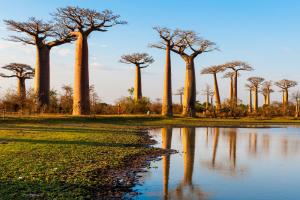
Gods in the branches
Native from Mexico to South America, the ceiba tree grows more than 200 feet with a base more than 65 feet in diameter. Its white, cotton-like seedpods (kapok) float in the air and its flowers are creamy-white and pink toward the edges.
The Mayan creator Xibalba was said to raise the ceiba tree at creation, an act celebrated at a shrine created from a large natural column found in Balamkanche Cave in the Yucatan. The huge conical thorns on the ceiba’s trunk were reproduced on Maya funerary urns.
The ceiba is the national emblem of Puerto Rico and Guatemala, with some of the oldest specimens towering over public gathering places in the cities of Puerto Rico, Guatemala, and Honduras. Some Amazonian tribes in eastern Peru say that deities live in the ceiba’s branches.
The mighty oak
In addition to the hazel tree, the Celts also assigned mythic properties to the oak tree, which grows up to 150 feet and lives more than a thousand years. In ancient Greece, the word for oak also meant tree. When coppiced, the oak sprouts rod-like branches.
In Ireland a magic harp made of oak was carried from the spirit world by the semi-divine chief Dagda, who once used it to lull his captors to sleep and escape. In County Kildare, a 450-foot magical oak was said to appear in the village of Mugna at the birth of a legendary king, producing three crops a year of acorns, nuts, and apples.
Archaeologists found an oak post at the center of a large circle at the site of Emain Macha, known as the castle of the Red Knights near the modern town of Armagh. Druids often held gatherings and taught their students under the largest white oak they could find.
The ageless yew
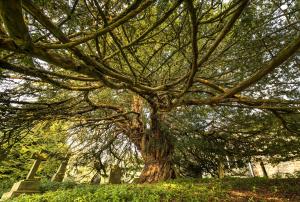
Yew trees and bushes can live more than 3,000 years by continually regenerating themselves. As the main trunk dies, new shoots rise from the base to become a new tree. Sometimes a drooping branch burrows below ground, develops a root system and becomes a separate tree.
An Irish legend tells of an enchanted yew on an island in Loch an Iuir (Lake of the Yew) in Donegal that was linked to a heavenly paradise, according to Niall Mac Coitir’s Irish Trees: Myths, Legends & Folklore (2003, The Collins Press). This link to paradise sheds light on the Celtic Chieftain Catuvolcus’ choice to eat poisonous yew berries as a form of suicide rather than surrender to the Romans as a slave.
In Celtic Brittany, the roots of a yew growing in a cemetery were said to extend into the mouths of the dead, presumably as a vehicle for souls to rise to heaven. Druids planted yews at sacred wells, temples, and burial sites. Some Celtic tribes were named after yews, signifying the tree’s connection to the world of ancestral spirits.
A remote grove of yews was considered a place of healing for men driven mad by warfare, such as “Mad Sweeney,” who fled to a valley of yews at Glenn Bolcain.
The Bodhi tree
Growing up to 100 feet, the sacred fig (Ficus religiosa) is a semi-evergreen native to India that runs with white sap and is also known as the Bodhi tree. The flowers bloom in February with large red petals surrounding a white cup-like feature topped with purple and yellow tendrils.
Known to grow wild in the foothills of the Himalayas, Hindu texts say Lord Indra planted a sacred fig on the polar Mt. Meru, at the center of heaven. The Buddha was said to attain enlightenment after meditating for six days under a Bodhi tree.
World trees in Siberia and Australia
Growing only along the rivers of Australia, the yaraan is a red gum tree with a white trunk and white flowers that bloom in groups of seven or nine. The Aboriginals of New South Wales say the Milky Way was a huge yaraan tree that grew up from the earth at Creation, with white cockatoos roosting in its branches. The yaraan showed its sadness at the death of people by weeping red tears on its white trunk and enabling the soul of the first man to reach his cosmic afterlife.
In Siberia the silver birch features white papery bark and was the world tree of the Yakut, who believed the first man at creation was fed from breasts half-emerging from its white trunk.
Birds of the world tree
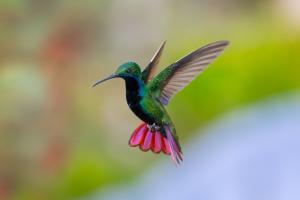
Another essential quality of world trees was an outstanding ability to attract birds, either with winter-blooming fruits and berries or super-fragrant flowers in spring that attract juicy insects, caterpillars, and moths.
Birds were widely perceived across the nature religions as guides for human souls through the afterlife. Across cultures the world tree motif featured a sacred bird on top with a snake at its base, likely representing rivers.
A wide variety of birds routinely nest in the natural cavities of the oak tree, which produces a bumper crop of acorns for crows and blue jays in the fall. In Ireland jays were once believed to be reincarnated druids.
The yew has a symbiotic relationship with cedar waxwings and thrushes, which gorge on its red berries all winter. Birds make yew seeds viable by breaking down their tough coating before dispersing them. The flowers of the ceiba tree attracts the hummingbird, considered sacred throughout the Americas.
More than half of all bird species eat the fruits of flowering trees and distribute their seeds in droppings. The tree helps the bird, and the bird helps the tree, a symbiotic relationship that’s existed for millions of years.
“The tree is given birth to by the bird,” is a phrase found in two Bantu dialects of South Africa, where indigenous tribes still limit hunting the guinea fowl, which eats insects and seeds of the thorn acacia tree, which is also protected.
The Christmas tree
In the final chapter of the New Testament, the Book of Revelation promises that souls who reach paradise on Judgment Day will enjoy the healing benefits of the eternal tree of life.
In The Mythic Image (1974, Princeton University Press), Joseph Campbell connected the Christian tree of life with the northern celestial pole, writing that the tree of life was “conceived as an axis extending vertically to the pole star and downward to some pivotal point in the abyss. Iconographically, it may be represented as a mountain, a stairway or ladder, a pole, or very commonly, a tree. It is symbolized in our Christmas tree, with the pivotal star at its summit, bounteous gifts appearing beneath…”
(Ben H. Gagnon is the author of Church of Birds: An Eco-History of Myth and Religion, which includes a review of 26 world trees around the world. The book will be released in March 2023 from John Hunt Publishing, London, and is now available for pre-order.)



